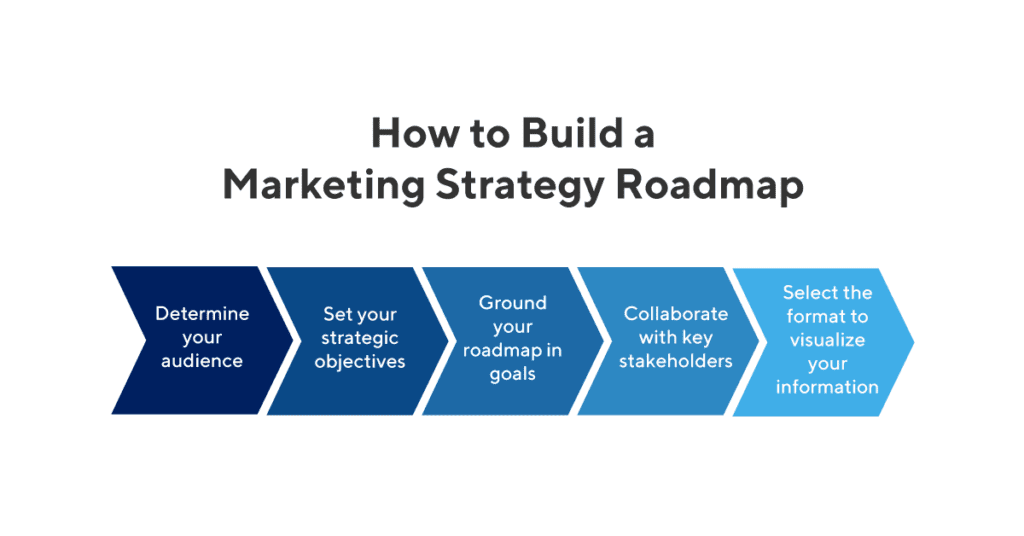Marketers shouldn’t be strangers to the concept of a roadmap. They’re consumers of product roadmaps, using them to understand the product strategy and timing of key releases.
Plus, they also sometimes use them to plan out their activities. They create timelines and plot out key dependencies and essential activities. They use that information to deliver the right messages to the right audiences at the correct times.
But those marketing roadmaps are highly tactical and granular. They’re about getting stuff done, not painting a picture of an overarching scheme.
Our topic here is higher-level marketing strategy roadmaps.
Why Do I Need a Marketing Strategy Roadmap?
A marketing strategy roadmap conveys your high-level marketing plan to key stakeholders across the company. It’s an umbrella roadmap for the individual plans for specific campaigns, events, and product launches. Rather than including the same level of detail as those more specific plans, they focus on the initiatives themselves.
This roadmap is useful as a reference tool for the marketing team. But its real value is in how it can educate the rest of the organization and build alignment and support. It shows you’re not taking a lazy approach to marketing and have thought things through.
The executive team is establishing the guiding principles and objectives of the marketing team. Those aren’t always obvious when considering any of the specific tactics.
And for other teams, it gives them insight into what marketing is doing. This insight connects the dots to show how marketing activities fit in with the product roadmap and sales plans.
You might be thinking to yourself that you already have a marketing plan, so why do you also need to create a roadmap. You should remember that most people will never actually read that marketing plan.
What Does a Marketing Strategy Roadmap Include?
A marketing strategy roadmap is defined as much by what’s not on it as what it contains. Good marketing strategy roadmaps eschew specific dates and individual marketing activities. Instead, they focus on significant initiatives, their sequence relative to each other, and key dependencies or gating factors.
In general, every item on the roadmap falls into one of three categories: analysis, execution, or evaluation. For example, the team would first research target markets and keywords. Then it would run targeted ads on digital platforms. Finally, they’d assess how the campaign performed to use those learnings for a more efficient spend the next go-round.
However, the marketing strategy roadmap wouldn’t include specific ads, dates, and channels for their campaigns. Those are far too granular.
Those would be in a tactical marketing roadmap specific to that initiative and used primarily by members of the marketing team. That level of detail simply isn’t required for this strategic roadmap’s audience.
Use swim lanes to categorize initiatives into functional areas. You’ll enable visual communication of the plan’s elements and how different actions and activities align with and support them. Imparting in this context is a significant benefit of presenting the marketing strategy in a roadmap format.
What’s the Best Process to Create a Marketing Strategy Roadmap?
Building a strategic marketing roadmap might feel like a foreign concept. But it’s not particularly challenging if you take a deliberate, linear approach to the process. Let’s break down the steps.

Determining your audience
You wouldn’t create an advertisement in a vacuum without thinking about your target. Construct this roadmap with the consumer in mind. Figuring out who’s going to look at the roadmap shouldn’t be tricky. It will be some combination of the following groups of stakeholders:
- Executive team
- Board members
- Investors
- Finance
- Product
- Sales
- Operations
Whittling that list down a bit will help with the next part of the equation: understanding what your audience cares about. Remember, this roadmap isn’t really for you. Tailor it to inform folks about your strategy and answer questions they’ll undoubtedly have.
There are many different types of stakeholders, and each has their own set of motivations. While everyone cares about the overall success of the company, they’re all focused on different aspects of it. Keeping that in mind will dictate what’s included and how it’s positioned for optimal results.
Setting your objectives
In this case, we’re not talking about the goals for the marketing strategy itself, but rather the aim of the roadmap. Are you looking for buy-in? Seeking an additional budget? Requesting resources? Simply providing an informational update?
If you intend to get something at the end of this—be it approval or a bundle of cash—then the roadmap should illustrate how the included items and their sequence will net results your stakeholders care about.
You should also define the scope of the roadmap early on, and there should always be more detail for short-term plans versus less-certain future possibilities.
Grounding it in goals
Like every other aspect of the business, companies don’t spend time and money on marketing just for the sake of it. They’re trying to make things happen, grow the business or improve profitability.
Match up elements of the marketing strategy roadmap with the KPIs, OKRs, and other significant metrics the entire organization is tracking and working toward. It demonstrates that marketing isn’t going rogue. It shows all the money and effort spent on the activities laid out in the roadmap have an ultimate purpose.
The ability to measure the impact these activities have on those key goals is an added benefit. This quantifiable analysis of the results justifies the associated spending. That, in turn, validates the marketing team’s approach.
Not going it alone
Don’t concoct a marketing strategy (nor its associated roadmap) in secret. It should be a collaborative, iterative exercise that taps the insights of internal resources. Collaboration paves the way for smooth sailing via previewing and conversations.
Start with establishing upfront who will need to sign-off on the strategy. Knowing which stakeholders have a say shapes the process and the included content. Meeting with these key individuals early and often to have some crucial conversations can avoid surprises and having to re-do work.
Beyond the gatekeepers, leveraging internal subject matter experts is also a wise move. Incorporate their wisdom instead of taking a “not invented here” approach to craft a thorough, bulletproof product.
Picking a format
Since roadmaps are light on text and heavy on presentation, which style you select can play an outsized role in the usefulness and reception of your roadmap. Relying on a tool that’s flexible and supports multiple formats is a smart move. You don’t want to get locked into a particular approach.
The big decision is whether to take a timeline, take on it, or adopt a list/Kanban-style roadmap format. The vision should help drive this choice. There may be a clear order of operations that maps well to a timeline, or it could be a host of discrete actions that can be worked on independently.
There’s no right or wrong answer for this one, it’s just whatever is the best fit for the situation at hand.
Take the Plunge, it’s Worth it!
Assembling a marketing strategy roadmap might feel like one more to-do list item that seems redundant and unnecessary. But there’s immeasurable value in having a single, at-a-glance source of truth for your entire marketing strategy.
It likely won’t need updating too frequently, either. While your tactical plans may vary often, your overall marketing strategy should remain relatively static. It will probably only require a tweak every quarter or so.
Best of all, you don’t have to start from scratch! With professional roadmapping tools and templates available, you can focus on the content and not spend hours futzing around in PowerPoint.
Want to make your own marketing strategy roadmap? Get started with a template.



